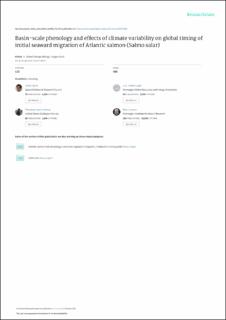Basin-scale phenology and effects of climate variability on global timing of initial seaward migration of Atlantic salmon (Salmo salar)
Otero, Jaime; L’Abée-Lund, Jan Henning; Castro-Santos, Theodore; Leonardsson, Kjell; Storvik, Geir O.; Johnsson, Bror; Dempson, J. Brian; Russell, Ian; Jensen, Arne Johan; Baglinière, Jean-Luc; Dionne, Mélanie; Armstrong, John Duncan; Romakkaniemi, Atso; Letcher, Benjamin Havens; Kovic, John F.; Erkinaro, Jaakko; Poole, Russell; Rogan, Ger; Lundqvist, Hans; MacLean, Julian C.; Jokikokko, E.; Arnekleiv, Jo Vegar; Kennedy, Richard; Niemelä, Eero; Javierre, P. Caballero; Music, Paul A.; Antonsson, Thorolfur; Gudjonsson, Sigurdur; Veselov, Alexey; Lamberg, Anders; Groom, Steve; Taylor, Benjamin; Taberner, M.; Dillane, Mary; Arnason, Fridthjofur; Horton, Gregg; Hvidsten, Nils A.; Jonsson, Ingi Runar; Jonsson, Nina; Mckelvey, Simon; Næsje, Tor Fredrik; Skaala, Oystein; Smith, Gordon W.; Sægrov, Harald; Stenseth, Nils Chr.; Vøllestad, Leif Asbjørn
Journal article
Permanent lenke
https://hdl.handle.net/11250/2738844Utgivelsesdato
2014Metadata
Vis full innførselSamlinger
Sammendrag
Migrations between different habitats are key events in the lives of many organisms. Such movements involve annually recurring travel over long distances usually triggered by seasonal changes in the environment. Often, the migration is associated with travel to or from reproduction areas to regions of growth. Young anadromous Atlantic salmon (Salmo salar) emigrate from freshwater nursery areas during spring and early summer to feed and grow in the North Atlantic Ocean. The transition from the freshwater (‘parr’) stage to the migratory stage where they descend streams and enter salt water (‘smolt’) is characterized by morphological, physiological and behavioural changes where the timing of this parr
-smolt transition is cued by photoperiod and water temperature. Environmental conditions in the freshwater habitat control the downstream migration and contribute to within - and among -
river variation in migratory timing. Moreover, the timing of the freshwater emigration has likely evolved to meet environmental conditions in the ocean as these affect growth and survival of the post-smolts. Using generalized additive mixed -effects modelling, we analysed spatio-temporal variations in the dates of downstream smolt migration in 67 rivers throughout the North Atlantic during the last five decades and found that migrations were earlier in populations in the east than the west. After accounting for this spatial effect, the initiation of the downstream migration among rivers was positively associated with freshwater
temperatures, up to about 10 ºC and levelling off at higher values, and with sea-surface temperatures. Earlier migration occurred when river discharge levels were low but increasing. On average, the initiation of the smolt seaward migration has occurred 2.5 days earlier per decade throughout the basin of the North Atlantic. This shift in phenology matches changes in air, river, and ocean temperatures, suggesting that Atlantic salmon emigration is responding to the current global climate changes.
